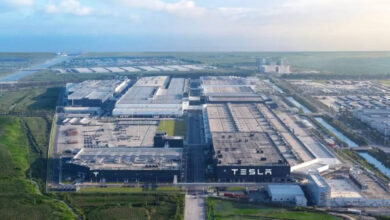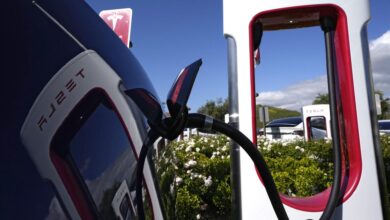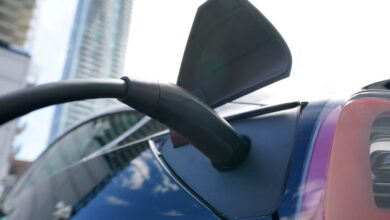How To Manage The Transition To Electric While Gas Cars Still Sell

Disruptive technology leaves corporate casualties in its wake – just ask Nokia and Ericsson how they feel about the Apple iPhone. The Battery Electric Vehicle (BEV) revolution threatens a similar fate for many incumbent automakers. But it’s not as simple as making the switch whether you like it or not. China’s BEV demand has softened in favor of burgeoning plug-in hybrids, and there are signs of growth slowing in Europe as well. The biggest challenge is managing an uncertain transition from fossil fuel to electric. One company trying to ease that shift is MAHLE Powertrain. I talked to its Director Engineering Services, Simon Reader, about the perils and pitfalls moving from combustion to electrons.
Pioneering Combustion Engines
MAHLE Powertrain has a long and checkered history delivering performance motors. “We’re an engineering consultancy,” says Reader. “Most of our work is in the early phases of development of power trains. Twenty years ago, this meant high performance combustion engines. We were the road engine counterpoint to Cosworth, which is still next door. Our focus was much more on delivering emissions-compliant engines for road car applications, while they were doing racing, mainly F1.”
MAHLE created the engine used in the legendary Ford Sierra RS Cosworth road car. (Photo by National … [+]
Some of these motors were used in now-legendary performance vehicles. “The Ford Sierra RS and Escort RS Cosworth engines were done here as part of Cosworth road engines, as was the original Mercedes 190E 16-valve conversion,” says Reader. “Since then, we’ve had to refocus on the whole powertrain, because these engines are decreasing in importance, and we need to substitute our business with other work. That has been our mission for the last 15 years. Initially we looked at hybridization. We did a project for a range extender in a car in 2010. We were probably too far ahead of our time, because range extenders are now becoming a thing, particularly in China with Li Auto. They have a range extender vehicle, which is selling quite well.”
“We looked at parallel hybrids, where we had a combustion engine in the front of the car and electric motors on the back, so you could use one or the other,” continues Reader. “In 2007, we did a three-cylinder downsized, highly efficient engine. Everybody said nobody will have three-cylinder downsized engines, they don’t work in big cars, so we put it in a Volkswagen Passat estate. Then all of a sudden we see the Ford Fox Engine appear and the PSA 1.2 PureTech and we were several years ahead of that.”
Taking On The Challenges Of Electrification
“We started our journey for electrification 10 or 15 years ago,” says Reader. “We are a global business, but our key areas are UK, US, China, and Germany. The speed of change is different in all those markets. MAHLE has three key strands – efficient combustion engine components, thermal management solutions and electrification. Our driver is to improve CO2 emissions.” However, Reader doesn’t see BEVs as the singular solution to this problem. “We’re not big fans of banning ICE vehicles. We would rather be technology agnostic. Set us the targets and as engineers, we’d love to meet them.”
MAHLE’s test facilities can put both EVs and ICE cars through their paces.
“The key message here in a global business is different markets, different targets, different technologies,” says Reader. “China now regards a highly efficient gasoline engine as a new energy vehicle. That creates a challenge for us because you can’t just shift the whole business to electric. We were developing highly efficient combustion engines. We’re now looking at renewable fuels, and how to have efficient vehicle systems because, whether it’s electric or something else, having an efficient system within the vehicle, such as the cooling system, is important. We can’t abandon ICE because certain markets aren’t abandoning it, and that still brings in a chunk of our income.”
“Most of the projects in China are still around ICE,” adds Reader. “They might be range extenders, or they might be a hybrid platform, but they’re still looking at engines. Some of that is because they focus themselves very heavily on battery technology, so we get the other part, which we’ve got the skills and capabilities for.”
Optimizing Every Type Of Power Train
The testing facilities MAHLE has on offer at its Northampton facility include the ability to assess all-electric and combustion systems aimed at two- and four-wheel-drive powertrains in environmental conditions ranging from -40 to +60C, humidity up to 80%, and simulated altitudes up to 5,000m. They have hydrogen supplies for motors using this fuel. These sit alongside facilities for cycling battery packs continually to assess endurance, with the ability to immerse the packs in water in the case of thermal runaway.
MAHLE now has facilities for testing the endurance of EV battery packs through multiple strenuous … [+]
“We do see that the batteries drop off with use, but there’s legislation coming about how much battery capacity needs to remain after a certain amount of time,” says Reader. Optimizing cooling is a key area of research for MAHLE here, where it can still deploy its knowledge from internal combustion. “A cylinder head on a combustion engine has real challenge from a thermal perspective. The combustion operates at over 1,000C. You’ve got 120C oil. You have water at 90 degrees. And the motor has to deal with this at thousands of rpm. Optimizing battery performance is a cooling challenge like this.”
MAHLE has developed technology to help combustion engines reach optimum temperatures as quickly as possible, because they are less efficient when cold, with higher emissions. “A battery is a similar device,” says Reader. “You want to get it into its optimum operating condition as quickly as you can. And then you want to keep it cool, whether it’s during the charging cycle, or whether it’s as you’re deploying the power on the road.” MAHLE is adapting its existing internal combustion expertise to electric drivetrains. The company has also recently helped develop a standard for wireless EV battery charging.
“The battery is the challenge of the future, whether that be performance, durability, or recyclability, rather than the motors,” adds Reader. “The motors are 90 percent efficient already. There’s not a great deal you can do other than make them more powerful. We treat cell technology like a black box. We need to understand how what’s in it works, but we don’t really need to understand the detail of the chemistry. Companies might use prismatic, cylindrical or pouch cells. We need to understand how to put them in the best package and get the most out of them. We don’t need to understand how the underlying chemistry works.”
Balancing Continuing Demande For ICE Against Growing EV Market
However, MAHLE is still helping develop some of the most advanced internal combustion engines around, integrated into advanced hybrid drivetrains. Most famously, MAHLE partnered with Zenvo to build the Aurora Hypercar’s V12 engine, supposedly the most powerful street legal motor of its kind with an output of 1,250hp. Electric motors then add a further 600hp for a total of 1,850hp, or they can be used for emissions-free driving.
MAHLE worked with Zenvo on the Aurora hypercar’s engines, which is the most powerful street-legal … [+]
However, Reader sees this transition phase as highly problematic for incumbent automakers, who must satisfy existing ICE demand while growing BEV orders. “Trying to build ICE cars down the same line as electric cars is the wrong answer,” he says. “The platforms are different, and we should be building them separately, but nobody wants to totally commit to that yet because it’s an expense.”
Power trains using ICE, BEV, and hybrids of the two aren’t the only considerations, either. “Hydrogen is another strand that we’re looking at,” says Reader. “Hydrogen is pretty much ruled out for road cars, but it may have a role to play for heavy duty trucks. There’s no doubt that electrification is the right answer for passenger cars, though, whether that be fully electric, or some kind of hybridization. We’re not going to meet the emissions that we need to meet to stem global warming by continuing as it is, that’s clear.”



